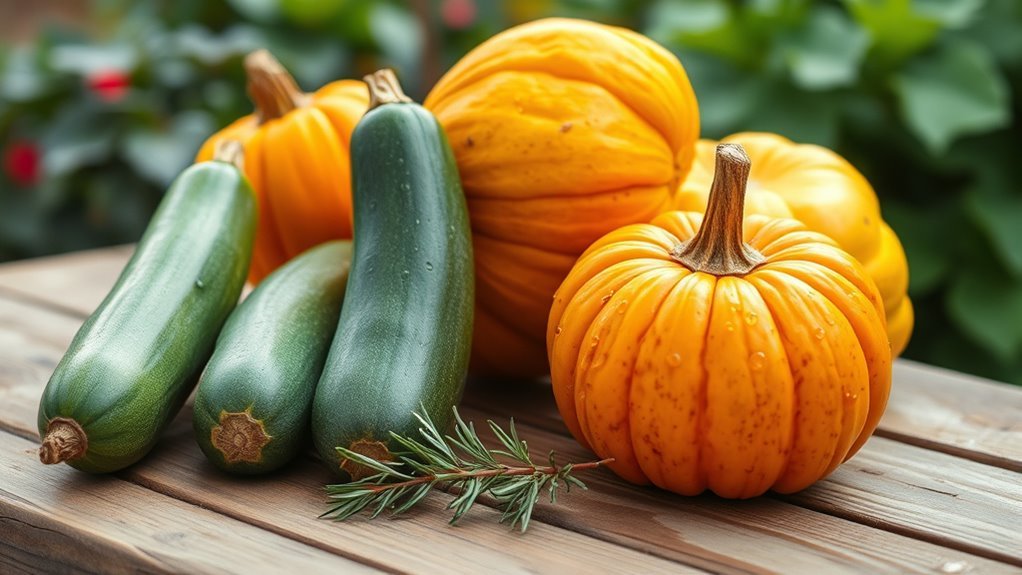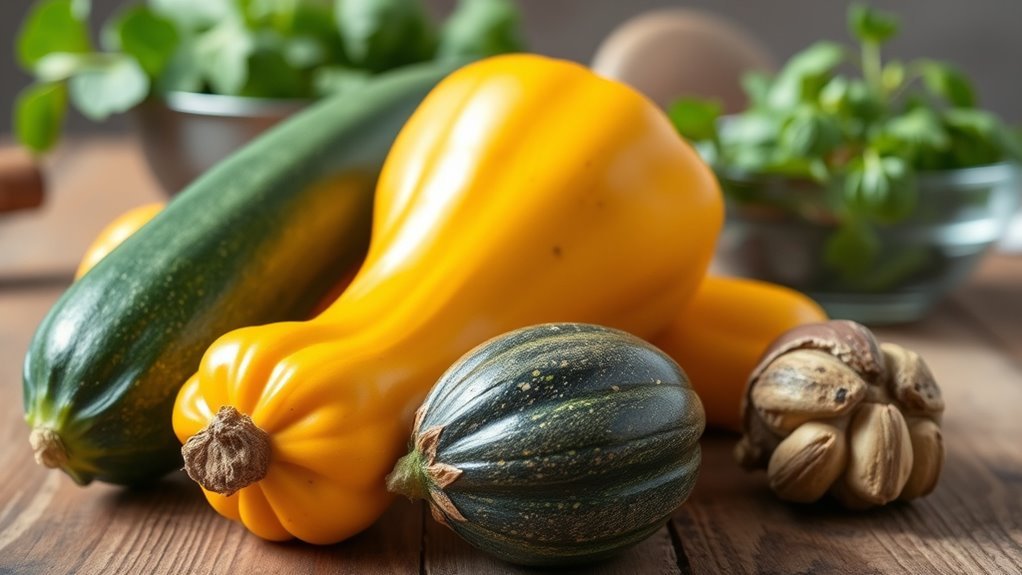Yes, squash can fit into a keto diet, but not all varieties are equal. Opt for low-carb options like zucchini and spaghetti squash, as they contain around 2-5 grams of net carbs per 100 grams. In contrast, butternut and acorn squash are higher in carbs, so consume them in moderation. Choosing the right types is essential for your keto success. To explore more about suitable squash and delicious recipes, stay with us for further insights.
Understanding the Keto Diet

When you immerse yourself in the keto diet, it’s essential to understand its core principles. The keto basics revolve around greatly reducing carbohydrate intake and increasing fat consumption. This shift encourages your body to enter a state of ketosis, where it burns fat for fuel instead of carbs. Dietary guidelines for a ketogenic lifestyle often suggest that your daily calorie intake should consist of approximately 70-75% fats, 20-25% protein, and only 5-10% carbohydrates. By adhering to these ratios, you’re not just following a diet; you’re embracing a new approach to eating that can lead to weight loss and improved energy levels. Understanding these fundamentals empowers you to make informed choices that align with your dietary freedom.
Types of Squash

When considering squash for your keto diet, it’s important to understand the different types available. Summer squash varieties, like zucchini and yellow squash, are typically lower in carbs, while winter squash options, such as butternut and acorn squash, tend to have higher carbohydrate content. Knowing the distinctions can help you make informed choices that align with your dietary goals.
Summer Squash Varieties
Though summer squash is often enjoyed for its tender texture and vibrant colors, understanding the various types can enhance your culinary experience. Popular summer squash varieties include zucchini, yellow squash, and pattypan. Zucchini, with its mild flavor, works well in both savory and sweet dishes, while yellow squash boasts a slightly nuttier taste. Pattypan squash, easily recognizable by its unique shape, adds visual appeal and a delicate flavor to your meals. Each of these summer squash varieties offers unique flavor profiles that can elevate your dishes, making them versatile ingredients in a low-carb, keto-friendly diet. Experimenting with different types can inspire creativity in the kitchen, allowing you to enjoy the freedom of cooking with fresh, seasonal produce.
Winter Squash Options
While summer squash brings a light and fresh flavor to dishes, winter squash offers a richer and heartier alternative that’s perfect for fall and winter meals. Common winter squash varieties include butternut, acorn, and spaghetti squash, each providing unique textures and flavors. These squash not only enhance your meals but also come packed with nutritional benefits. They’re generally low in calories and high in vitamins A and C, fiber, and antioxidants. Incorporating winter squash into your diet can support overall health while fitting into a low-carb lifestyle. Just be mindful of portion sizes, as some varieties can be higher in carbs than others. Embrace these versatile options to enjoy satisfying, nutrient-dense meals this season!
Nutritional Breakdown of Common Squash Varieties

Although many people enjoy squash for its versatility and taste, understanding the nutritional breakdown of different varieties is essential for those following a keto diet. Zucchini, with its low calorie count and high water content, offers great nutritional value while providing fiber and vitamins A and C. Butternut squash, on the other hand, is denser and offers more carbohydrates, making it less ideal for strict keto followers. Acorn squash boasts a moderate amount of carbs but also delivers significant health benefits, including antioxidants and potassium. When choosing squash, consider its nutritional profile to align with your dietary goals while enjoying its natural flavors and textures. Balancing taste and health can lead to satisfying meals on your keto journey.
Carb Content Comparison
When considering squash in your keto diet, it’s important to compare its carb content with other vegetables. While some squash varieties contain more carbohydrates than others, many can still fit within a low-carb lifestyle. Understanding these differences can help you make informed choices that align with your dietary goals.
Nutritional Breakdown of Squash
Understanding the carb content of squash is essential for those following a keto diet, as it can vary considerably among different types. Here’s a quick comparison of popular squash varieties:
- Zucchini: About 2 grams of net carbs per 100 grams; great for stir-frying or grilling.
- Butternut Squash: Contains around 12 grams of net carbs per 100 grams; best roasted for rich flavor.
- Acorn Squash: Approximately 9 grams of net carbs per 100 grams; delicious when baked with spices.
- Spaghetti Squash: Roughly 5 grams of net carbs per 100 grams; perfect for creating low-carb “pasta” dishes.
Each type offers unique health benefits, making them versatile in various cooking methods. Choose wisely to maintain your keto lifestyle!
Comparing With Other Vegetables
While squash can fit into a keto diet, it’s important to compare its carb content with other vegetables to make informed choices. For instance, zucchini, a type of squash, offers a low-carb option, with about 3 grams of net carbs per serving. In contrast, starchy vegetables like potatoes and corn contain considerably higher carb levels, making them less ideal for keto dieters. When considering your options, think about the diverse squash textures and vegetable flavors that can enhance your meals without packing on carbs. Leafy greens like spinach and kale are also great low-carb choices, providing rich nutrients. Balancing these choices allows you to enjoy the freedom of flavors while adhering to your keto lifestyle.
Are All Squash Types Keto-Friendly?
Which types of squash can fit into a keto diet? Not all squash varieties are created equal when it comes to keto compatibility. While some can be enjoyed in moderation, others may not align with your carb goals. Here’s a quick breakdown:
- Zucchini: Low in carbs, it’s a great keto-friendly option.
- Spaghetti Squash: Offers a unique texture and is relatively low in carbs.
- Butternut Squash: Higher in carbs, so enjoy it sparingly.
- Acorn Squash: Moderately high in carbs, best used occasionally.
Understanding these distinctions can help you make informed choices on your keto journey. Embrace the freedom to choose wisely while enjoying the flavors that squash has to offer!
How to Incorporate Squash Into a Keto Meal Plan
If you’re looking to incorporate squash into your keto meal plan, focusing on low-carb options like zucchini and spaghetti squash is key. You can find delicious keto recipes that highlight these squash varieties, making meal prep both enjoyable and nutritious. With a little creativity, you can seamlessly integrate squash into your meals while keeping your carb intake in check.
Low-Carb Squash Options
When you’re following a keto diet, incorporating low-carb squash options can enhance your meals without derailing your carbohydrate intake. Here are some great ways to enjoy squash while sticking to your low carb recipes and keto friendly snacks:
- Zucchini Noodles: Swap traditional pasta with spiralized zucchini for a satisfying base.
- Spaghetti Squash: Roast it and scrape out the strands for a delicious, low-carb pasta alternative.
- Butternut Squash: Use in moderation; it’s slightly higher in carbs but can be roasted or pureed for flavor.
- Acorn Squash: Bake it with butter and spices for a tasty side dish that won’t break your carb bank.
These options not only keep your meals diverse but also align perfectly with your keto lifestyle!
Delicious Keto Recipes
Incorporating squash into your keto meal plan can be both delicious and straightforward, as these versatile vegetables offer unique flavors and textures. Squash benefits are numerous; they’re low in carbs and high in fiber, making them an excellent choice for keto meal prepping. Try spiralizing zucchini for a pasta substitute, or roasting butternut squash with olive oil and spices for a flavorful side dish. You can also make a creamy squash soup, blending it with broth and herbs for a satisfying, low-carb option. With so many ways to enjoy squash, you can easily add variety to your meals while staying within your keto guidelines. Embrace these recipes for a tasty, healthy lifestyle!
Meal Prep Ideas
While you might think of squash as a seasonal ingredient, it can be a staple in your keto meal prep all year round. Incorporating squash into your recipe planning is easy and versatile. Here are some ideas to get you started:
- Stuffed Squash: Fill halved squash with ground meat, cheese, and spices for a hearty meal.
- Squash Noodles: Use a spiralizer to create low-carb noodles, perfect with your favorite keto sauce.
- Roasted Squash: Toss cubed squash with olive oil, salt, and herbs for a delicious side dish.
- Squash Soup: Blend cooked squash with broth and seasonings for a creamy, comforting soup.
With these meal prep ideas, you’ll enjoy a satisfying, keto-friendly diet that embraces the deliciousness of squash!
Delicious Keto Squash Recipes
If you’re looking to spice up your keto meal plan, delicious squash recipes can be a fantastic addition. One great option is zucchini noodles, commonly known as “zoodles.” They’re a low-carb alternative to traditional pasta and pair well with various sauces and toppings. You can sauté them with garlic and olive oil or add them to a hearty meat sauce for a filling meal.
Another enticing dish is stuffed squash. Halved acorn or butternut squash can be filled with a mixture of ground meat, cheese, and spices, then baked until tender. This not only provides a satisfying meal but also showcases the natural sweetness of the squash. These recipes keep your diet exciting while ensuring you stay on track with your keto goals.
Tips for Selecting and Storing Squash
Selecting and storing squash properly can greatly enhance its flavor and longevity. Here are some key squash selection criteria and storage tips to keep in mind:
- Choose Firmness: Look for squash that’s firm to the touch, with no soft spots or blemishes.
- Check Color: A vibrant, rich color indicates ripeness; dull or pale squash may be under-ripe.
- Size Matters: Opt for smaller to medium-sized squash; they tend to be more flavorful and tender.
- Store in a Cool, Dark Place: Keep squash in a pantry or cellar, away from direct sunlight, to prolong freshness.
Potential Health Benefits of Squash
Squash offers a variety of health benefits that can support a balanced diet. Packed with essential nutrients, it’s low in calories while providing fiber, vitamins, and antioxidants. Its high fiber content can aid digestion, helping you feel full longer and promote healthy bowel movements. The rich nutritional value of squash includes vitamins A and C, which are crucial for immune function and skin health. Additionally, the antioxidants found in squash may help reduce inflammation and lower the risk of chronic diseases. Incorporating squash into your meals can also contribute to heart health by supporting healthy blood pressure levels. Overall, enjoying squash not only adds flavor but also enhances your overall well-being.
Final Thoughts on Squash and Keto Diets
While many might wonder about the compatibility of squash with a keto diet, it’s essential to assess the specific types of squash and their carbohydrate content. Not all squash varieties are created equal when it comes to keto compatibility. Here are some key points to reflect on:
- Zucchini: Low in carbs, making it a great option for keto.
- Butternut Squash: Higher in carbs, so consume in moderation.
- Spaghetti Squash: A low-carb alternative that can replace pasta.
- Acorn Squash: Moderate in carbs; keep portion sizes in check.
Ultimately, enjoying squash on a keto diet is possible, but focus on the varieties that align best with your carb goals. Remember, balance and moderation are key!


